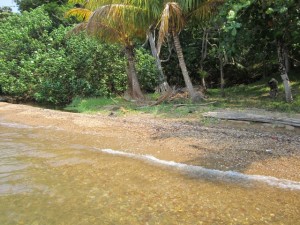
Creek in woods at Port Royal, Roatan
This is one of four known watering places in Port Royal harbor at the time Edward Low’s pirate crew arrived there in 1723 and may be where Ashton came ashore and escaped. The men from Low’s crew rolled wooden casks up onto the beach. A small fresh-water creek is visible just over the rise of the beach on the left.
While the men were filling the water casks near the wooded shore of Roatan, Ashton stepped onto the beach and started walking slowly along the sand, stopping occasionally to casually pick up a stone or shell as he moved away from the men. As the distance between Ashton and the men grew, Ashton edged slightly closer to the woods that bordered the beach. The cooper looked up and called out to him — where did he think he was going? Ashton said he was going to look for coconuts, since some coconut trees were growing near the beach. That seemed to satisfy the pirates for the moment and Ashton kept walking. Then, in an instant, Ashton turned away from the water and into the woods. The woods were so thick that within a dozen steps, he was completely hidden by the dense overgrowth and was able to hide silently until the pirates were gone.
While researching Ashton’s incredible story, I spent close to a week on this remote section of Roatan — even today, accessible only by boat — where he escaped. The reality of Ashton’s situation was that he was not only alone on an uninhabited island, but that he had marooned himself with practically nothing. “I was upon an island from whence I could not get off,” Ashton wrote. “I knew of no humane creature within many scores of miles of me; I had but a scanty clothing, and no possibility of getting more; I was destitute of all provision for my support, and knew not how I should come at any; everything looked with a dismal face.” How did Ashton survive? What did he eat, where did he live, and where would he have set up lookouts to watch for passing ships? During my time in Roatan, I uncovered new evidence about Ashton’s experiences. I used a rare 1742 survey to identify the creek where the pirates likely stopped for water and roamed the island to locate and taste the tropical fruits that sustained Ashton.
To learn more about my exploration of Roatan in pursuit of Ashton’s story, check out my new article in the latest issue of Bay Islands Voice.






